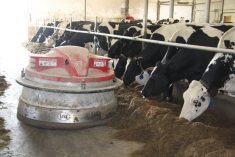At the end of two hours of debate about banning gestation stalls, two University of Manitoba agriculture students wondered whether much had been accomplished.
“It’s pretty much what I already knew,” said Christian Hinrichs, whose family operates a dairy farm at Whitemouth, Man.
“I spent a lot of time in Europe and I saw this happening and it’s only a matter of time before it hit here.”
Ian Froese of Boissevain, Man., agreed.
Read Also

Soybean market still figuring out implications of China-U.S. pact
Soybean futures had a muted reaction to the U.S. trade deal with China as the market tries to figure out the nuances of the deal.
“They all seemed to say the exact same thing,” he said. “It wasn’t too informative for me.”
All the speakers at the debate, which was organized by the university’s agriculture department, agreed gestation stalls for pigs will inevitably be phased out, but they also agreed the stalls can’t be eliminated quickly.
“I’m with you,” said Paul Shapiro, the Humane Society of the United States’ lead campaigner against large farms.
“I don’t think it’s reasonable that people can switch these types of systems overnight. These are industrial operations and you can’t just rip all the gestation crates out overnight.”
Shapiro was one of the leaders of the 2008 campaign in California to ban gestation crates and other confinement systems in the state by 2015. California is not a major hog producing state.
English professor and Winnipeg Humane Society activist Dana Medoro agreed.
“I would never presume to say we need to do this in 12 months.”
Wayne Lees, Manitoba’s chief veterinary officer, said he thought the switch away from gestation crates was inevitable. Maple Leaf and Smithfield have already said they want to eventually buy pigs from barns that don’t use them.
“I think that ship has already left port,” said Lees.
“I think as we move forward, we will see fewer and fewer gestation stalls.”
Laurie Connor, the head of the University of Manitoba’s animal science department, said she was pleased that opponents recognized switching to a non-stall gestation system could not be done quickly.
“I think we’ve all agreed that phasing out is absolutely essential. There are definitely problems (in a group housing system),” said Connor, a swine behaviour expert.
While stall defenders and opponents agreed gestation stalls will be phased out, they didn’t talk much about how that would happen.
American activist groups and the Winnipeg Humane Society have fought for government bans and regulations, while hog industry proponents have promoted voluntary methods.
There was also no agreement over whether gestation stalls are inhumane.
Connor and Lees encouraged the audience, which mostly comprised agriculture students but also other students, activists and interested people, to not assume pigs think and feel the same as people.
They said a stall system that may look inhumane to a human may seem comforting to a pig. If a pig in a stall system is healthy, it’s probably happy.
However, opponents portrayed stalls as prison cells and North American production methods as backward compared to European systems.
Winnipeg vegetarian activist Twyla Francois showed pictures of animals injured by inhumane treatment, offered statistics of the number of pigs killed in hog barn fires and said European pig farmers who had switched to non-stall systems were happier.
Agriculture student Kelly Burch told the presenters that the main concern of people on farms is how quickly they will be forced to move away from gestation stalls and how that conversion would be funded.
“We’re definitely not against phasing out of gestation crates, but one of the concerns of pork producers is a quick ban on gestation crates and not having a chance to convert their current barn systems into new barn systems, and where that funding is going to come from,” Burch said.
She wondered if the humane societies would help pay for those costly barn refits. Shapiro said his organization didn’t have enough money for that.















